For the reader who does not want to spend hours delving into the research methodology, this chapter provides an overview of the key findings. Subsequent chapters will discuss them in further detail and derive recommendations for action. For the detailed “how-to” methodology that produced these findings, please refer to Appendix 1. If you want to skip to a detailed discussion of the key results, please move from here to Chapter 3.
The State of Vitality in a Nutshell
The sector has the “hardware,” but not all of the “software,” that it needs to be most effective.
Our analysis found that the Lemanic philanthropic sector has significant strengths, sometimes in surprising areas. Beyond the high concentration of wealth in the region, which is well known and therefore not reported among the key results below, two critical aspects of a thriving philanthropic sector stood out by receiving high ratings. First, despite some differences between the two cantons, the sector overall scored well on policy incentives for donations, meaning that there are productive incentives in place to encourage the owners of the region’s wealth to put it to use serving the greater good. Second, and particularly encouragingly, the public opinion survey showed that the public in Geneva and Vaud trusts the philanthropic sector highly, both relative to other sectors in the region and in international comparison.
The Lemanic region therefore possesses three of the fundamental building blocks of a strong philanthropic sector: wealth, incentives to donate, and the confidence of the general public in the usefulness of foundations and philanthropy. In order to realize its full potential, however, it will need to improve in several areas. First, while the public expresses high confidence in foundations to “do the right thing,” the foundations themselves will likely need to become more transparent and accessible in order to maintain that trust over the long term. Second, according to foundation leaders who responded to our perception survey, people holding leadership positions in foundations, as a whole, neither are particularly diverse nor necessarily possess all of the right skill sets. Finally, while we are very grateful to the surveillance authorities in Geneva and Vaud for having agreed to share the risk criteria they use to evaluate the foundations under their supervision, more work could be done to publicize and align the work of the regulatory authorities.
Before moving on to the key results, it is worth saying a few words about our attempts to measure collaborations between foundations and local institutions as an indicator of philanthropic vitality. The Lemanic region has a well-earned reputation as a global hub for NGO and multilateral activity, hosting hundreds, if not thousands, of such organizations. As NGOs and multilateral bodies are both beneficiaries of and inspirations for philanthropic actors, we thought that their presence in such a high concentration could be a key contributor to philanthropic vitality. Our attempts to measure that contribution for this study, however, did not produce conclusive results, and future iterations of the study would be well advised to seek out other ways to assess this dimension of philanthropic vitality.
Development Priorities in Summary
As portrayed in the summary Figure 1 above, the indicator results lead directly to six potential action areas, which we will discuss in detail below:
- Assemble a funders’ coalition for the vitality of the Lemanic philanthropic hub. To guide and resource the common agenda envisioned above, as well as new ideas that are bound to emerge:
- Work with lead funders, including local authorities as key partners, to create and maintain a coalition of champions committed to sector vitality and the possibility of doing things better and more efficiently, and tasked with furthering the sector’s development, including periodic re-assessments of progress
- Communicate for vitality. To sustain public trust, improve the online presence of foundations, and promote local collaborations and partnerships with institutions:
- Work with local intermediaries in the short term to create new communications capacity to carry philanthropic stories through old/new media
- Help foundations get online
- Create a sector fact sheet to provide guidance for new donors and increase the profile of the Lemanic philanthropic hub
- Promote board and staff education. To underpin progress on skills and diversity, all areas of accountability, growth in association membership, and academic research and education capacity:
- Define an appropriate curriculum based on a shared understanding of the necessary capacities for foundation leaders
- Work with academic centers, foundation associations and umbrella foundations in the short-to-medium term to develop a comprehensive executive education program with accreditation
- Continue to grow association-based education and knowledge transfer
- Accelerate trends towards transparency. To sustain public trust, public reporting, and accountability across all sub-indicators and collaboration:
- Work with authorities and local intermediaries (or a new entity) in the short-to-medium term to develop a voluntary reporting platform to gather (machine-)readable data on foundations’ activities
- Expand the foundation mapping study in the canton of Geneva (see Figure 14 in Appendix 2) to include Vaud
- Deepen research on foundation transparency in Switzerland
- Accelerate the growth of umbrella foundations and study the need for a territorial foundation. To further stimulate a culture of giving in the general population, grow funds in umbrella foundations, and stimulate local collaboration:
- Work with cantonal authorities, philanthropists and foundations, and local institutions and interest groups in the short-to-medium term to deepen partnerships between local intermediaries and authorities to accelerate the transfer of smaller foundations to umbrella structures
- Conduct a feasibility study for a new territorial foundation to support donor engagement and collaboration around local needs, either as a new entity or embedded in current organizations
- Align cantonal best practices and requirements. To facilitate registration, increase value from surveillance, and further improve policy incentives, board and staff skills, and diversity:
- Work with authorities in the medium term to align risk management criteria and sharing of aggregated information on the sector
- Align on Vaud’s guichet unique practices, which allow foundations to interact with only one cantonal authority, and Geneva’s policies regarding foundations’ ability to conduct activities abroad and board remuneration practices
- Evolve fiscal exoneration practices relating to foundations’ commercial activities
Overall, the purpose of the vitality assessment is to nurture a collective effort to reinforce the Lemanic region as a global philanthropic hub. For this purpose, we must understand what vitality entails and how to measure it, and then act on the assessment’s results to improve the philanthropic sector’s potential to benefit society.
In Appendix 1: Detailed Methodology, we explain which indicators of performance were selected for each dimension, and how data was collected. We also provide details of the questions asked on our public opinion survey and some statistics regarding the respondent pool.
In Chapter 3, we explain how the Lemanic region performed on this first pilot assessment, with a focus on eight key indicators that provided fresh and relevant insights. The results of the other 14 indicators can be found in Appendix 2: Remaining Indicator Results.
Finally, in Chapter 4, we discuss the sector development opportunities that might most influence future philanthropic vitality over time, as proxied by indicator performance, and suggest potential lead sector actors and a potential timeline for each recommended action.
Appendix 3: Partners and Collaborators lists the institutions and individuals whose support helped to make this study a reality.
Throughout, we have sought to err on the side of readability and attractiveness of this study to a wider public: readers who are interested either in the potential of effective philanthropy in the Lemanic region specifically, or in a blueprint how to assess and stimulate philanthropic vitality more generally. We have thus relegated sources and more complex technical discussions to appendices and footnotes.
On Methodology: How Vitality Was Measured
Based on an extensive literature review and additional expert input, the project team identified six overarching categories of factors that influence philanthropic vitality. All of the indicators measured for this study fell into one of the following six categories:
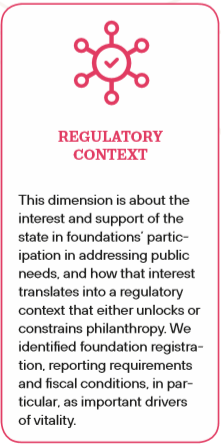
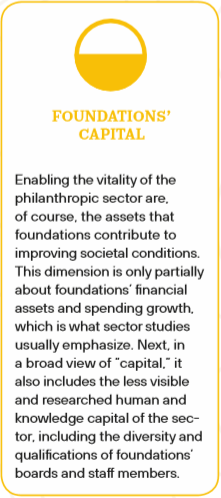
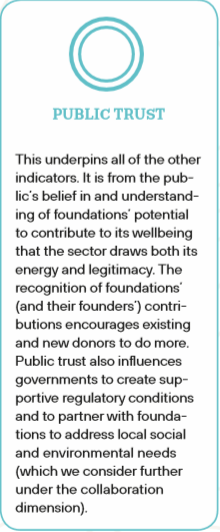
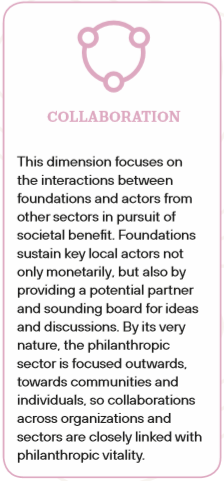
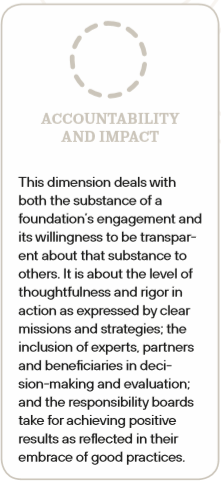
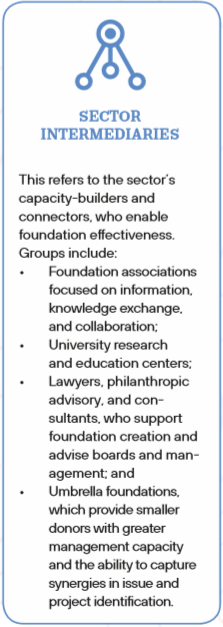
By combining extensive desk research with a series of 43 expert interviews, we selected 22 indicators to evaluate across these six categories. Measurement of the indicators incorporated further desk research and data provided by project partners and by the cantonal authorities, as well as a qualitative stakeholder perception survey (see column at right). For one indicator, namely indicator 3.3 (public trust), the Steering Committee commissioned a third-party survey firm to conduct a telephone survey of a representative sample of 310 members of the general public in the two cantons.
Stakeholder Perception Survey Methodology
The areas of inquiry determined by the indicator selection process guided the questions and design of a stakeholder perception survey. Questions were organized along the six dimensions of sector vitality and matched to each indicator, where relevant.
For example, an indicator under “public trust” is the extent to which Lemanic media covers public utility foundations and whether the coverage is positive or negative. The matching question in the survey asked stakeholders whether they believe the media covers the sector adequately, based on a five-point scale from “strongly disagree” to “strongly agree” (commonly referred to as a Likert scale). In addition, comment boxes allowed participants to provide further detail or recommendations to improve performance on that indicator (see Appendix 1 for the list of the specific questions asked). Indicators that relate purely to statistical patterns, such as the growth in the number of foundations, were fully assessed quantitatively, and were therefore not included as questions to stakeholders. The online survey was sent to 500 stakeholders, of whom 116 answered it, producing a response rate of 23%.
Public Opinion Survey Methodology
Due to the lack of data available on the public’s trust and general understanding of public utility foundations, the LINK Institut was requested to perform a public opinion survey of the general population in Geneva and Vaud, drawn from a pool of 27,000 potential respondents in Suisse Romande between the ages of 15-79. The final sample included 310 people, and the margin of error for the full survey results was +/- 5.7%.
Results of the survey can be found in Chapter 3 under indicator 3.3, and further details on the methodology, including the full text of the questions and a breakdown of the respondents, are included in Appendix 1.